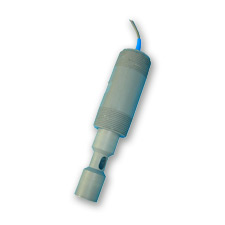Toroidal / Inductive Conductivity Sensors
Toroidal or Inductive Conductivity Sensors are sometimes described as Electrodeless Conductivity Sensors as they don't use the same cell formation as a standard 2 pole conductivity cell or a 4 pole conductivity cell.
The Inductive Conductivity Cells use two toroid shaped windings (doughnut shaped formations) which are immersed into the measured solution. These windings are known as the driver toroid and the receiver toroid. The driver toroid has an AC voltage applied to it, which induces a voltage into the measured solution. This voltage results an ionic current being generated in the surrounding ions which in turn generate an electric current being generated in the second wire wound toroid, the receiver toroid. The electric current generated in the receiver toroid is directly proportional to the conductivity of the measured solution.
As the applied voltage to the driver current is a known value and the current of the receiver toroid can be measured, we can derive the resistance / conductivity of the measured solution very accurately.
Inductive Conductivity Sensor Advantages
The inductive or conductivity sensors offer a number of distinct advantages over their standard counterparts.
Firstly - the toroids can be encased in any non conducting material - meaning that they can be placed into very chemically resistant materials like cPVC or PVDF so that they can be used in concentrated chemicals or in aggressive environments.
Secondly inductive conductivity sensors are non-fouling. As there are plates or electrodes in contact with the measured solution, the inductive conductivity sensors cannot be coated by solutions with high levels of suspended solids.
Thirdly the inductive conductivity sensors require relatively infrequent calibration or preventative maintenance compared to a standard conductivity cell where the measuring apparatus is in contact with the measured solution.
Finally the inductive conductivity sensors are able to measure conductivity ranges higher than a standard conductivity cell - in fact solutions with high conductivities produce a larger more easily measured current, which makes toroidal or inductive conductivity cells the perfect choice for CIP and solution strength control applications.
Inductive Conductivity Sensor Disadvantages
As with all things engineering - there are positives and negatives to everything. As the methodology for deriving the conductivity value is based the generation of an ionic current - where solutions have very low conductivities such as ultra-pure water, reverse osmosis, De-Ionised water and some towns water applications - it becomes very difficult to generate an ionic current.
When considering a conductivity sensor, if the measured solution has a conductivity below 100µS we would recommend using a 2 wire or a 4 wire conductivity cell.
Blind Inductive Conductivity Sensors (Transmitters)
Within our range of Inductive or Toroidal conductivity sensors we have a range of blind toroidal conductivity transmitters called our BCT range. These conductivity transmitters have inbuilt electronics to calculate a 4-20mA value proportional to the conductivity value within the conductivity sensor itself, eliminating the need for a separate conductivity transmitter.
The BCT range use the two wire 4-20mA industry standard to transmit the signal to a receiving device (such as a data logger, PLC, or chart recorded) up to 1000m and use two wires to power the device, as are used to transmit the signal.
Toroidal / Inductive Conductivity Sensor Range
C3655 & SI315
The C3655 is a conductivity controller with adjustable set-point and delay timer designed to work with our SI315 toroidal or inductive conductivity sensor.
The SI315 and C3655 electrodeless controller are able to work across the 0 - 200mS or 0 - 2000mS range and is designed specfically for industrial processes to give electrodeless control of an industrial applicaton.
The C3655 is commonly used in power generation plants, water treatment plants and is commonly used for solution strength control applications.
The C3655 and SI315 use automatic temperature compensation fixed at 2% / ºC with the temperature circuitry combined within the toroidal conductivity sensor.
BCT10 - Toroidal Conductivity Cell with built in 4-20mA for 0-10mS
The BCT10 is an inductive or toriodal conductivity transmitter, which boasts non-fouling operation and integrated electronics to provide a 4-20mA signal.
The BCT10 is a non fouling blind electrodeless transmitter manufactured in cPVC and provides a 2 wire output carrying the isolated 4-20mA current signal.
The BCT10 provides a 4-20mA output signal, fully isolated and temperature compensated across the 0 - 10mS range
BCT100 - Toroidal Conductivity Cell with built in 4-20mA for 0-100mS
The BCT100 is an inductive or toriodal conductivity transmitter, which boasts non-fouling operation and integrated electronics to provide a 4-20mA signal.
The BCT100 is a non fouling blind electrodeless transmitter manufactured in cPVC and provides a 2 wire output carrying the isolated 4-20mA current signal.
The BCT100 provides a 4-20mA output signal, fully isolated and temperature compensated across the 0 - 100mS range
BCT1000 - Toroidal Conductivity Cell with built in 4-20mA for 0-1000mS
The BCT1000 is an inductive or toriodal conductivity transmitter, which boasts non-fouling operation and integrated electronics to provide a 4-20mA signal.
The BCT1000 is a non fouling blind electrodeless transmitter manufactured in cPVC and provides a 2 wire output carrying the isolated 4-20mA current signal.
The BCT1000 provides a 4-20mA output signal, fully isolated and temperature compensated across the 0 - 1000mS range






